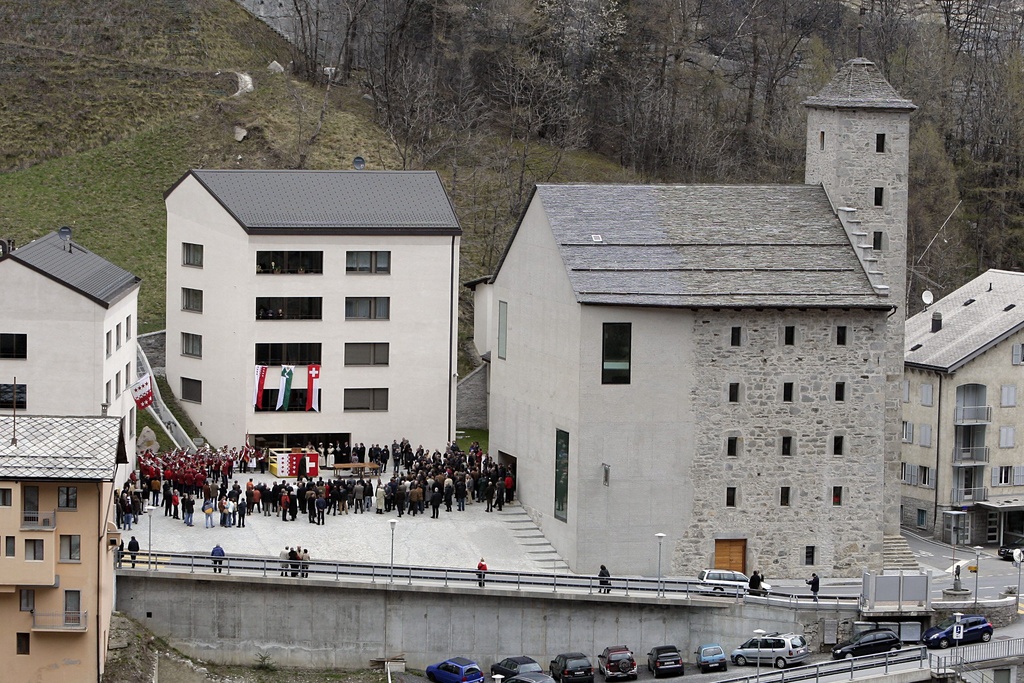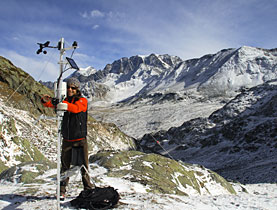Gondo marks tenth anniversary of disaster

Ten years ago 13 people were killed by a landslide in the Swiss village of Gondo. Commune president Roland Squaratti tells swissinfo.ch how life has changed.
On October 14, 2000, the tiny village on the Swiss-Italian border was sliced in two by a 40-metre-wide swathe of mud and rocks loosened by three days of torrential rain.
The heart of the village was destroyed and almost all the 165 surviving inhabitants were evacuated. The landslide swept away ten houses, the school, shops and the road. It also reduced most of the Stockalper Tower to rubble, leaving only the very oldest part of the building standing.
The tower was built by a noble Valais family in the 17th century. At the time, the Simplon road – on which Gondo stands – formed part of an important trading route between northern and southern Europe. Even today, up to 100,000 trucks pass through the village a year.
Three years ago the Stockalper Tower reopened as a hotel restaurant, after a SFr7.5 million ($7.8 million) reconstruction.
Squaratti was also commune president during the catastrophe, in addition to being a member of the village fire brigade.
swissinfo.ch: Ten years on, what is the atmosphere like in Gondo?
Roland Squaratti: The atmosphere is good. We finished the reconstruction four or five years ago, with the final part coming in 2007 when the Stockalper Tower was turned into a restaurant, which brings a lot of people to Gondo. Companies from all over Switzerland come here for courses that last from a day to a week. They stay the night and bring a lot of life to the village.
swissinfo.ch: What is planned for October 14?
R.S.: We’ll hold Mass at 10.30 in the morning – the catastrophe happened at 10.45 – followed by drinks on the village square. During that we’ll give a small present to the helicopter pilot who in 2000 flew blind through the Gondo gorge to evacuate us. We’re giving him something on behalf of all the rescuers and helpers.
In the wall behind Gondo we’ve recently installed 13 stars, and on the 14th, when it’s dark, we’ll light up these stars for the first time in memory of the 13 victims.
swissinfo.ch: Has anything changed in the past decade?
R.S.: Things have certainly changed – above all the number of inhabitants. Previously some 160 people lived here, now it’s about 100. Community life has obviously been affected a bit – virtually every inhabitant has to be in every association to maintain a decent community life.
We also work a lot more with the neighbouring Simplon commune when it comes to schooling and the post and so on – a regional mentality has developed between the two communes.
swissinfo.ch: Are you now better prepared for natural disasters?
R.S.: Safety measures were taken in the years after the catastrophe – a drainage system was constructed at the foot of the cliff to divert water around the village. In addition the holes in the rockslide protection wall were filled in.
That took two years or so. After that, another couple of years were spent rebuilding the village. The Stockalper Tower was renovated with support from a foundation and rebuilt as a hotel restaurant. That was finished in 2007.
As for catastrophes – we live in the mountains. A rockfall or something is always possible, but we’ve done everything humanly possible to guarantee the safety of the village and to prevent a repeat [of 2000].
Regarding landslides, we’ve taken safety measures but behind Gondo there’s a 400-metre cliff face and obviously it’s always possible that a rockslide will occur one day – but that’s a danger we live with in the mountains.
Since the introduction of the safety measures it’s rained very hard three or four times and we were able to see that the measures were good and that there was no risk. That brought back confidence.
June 8, 2007: Three people died in flooding in Huttwil and Eriswil (canton Bern).
August 21-23, 2005: Eight people died after heavy rainfall and flooding in Bern and east and central Switzerland. Many road and rail connections were washed out, with the villages of Engelberg and Lauterbrunnen cut off. The damage came to SFr2.5 billion.
October 14/15, 2000: Persistent rain in canton Valais led to landslides and flooding. Sixteen people died, including 13 in the village of Gondo. The bill came to SFr500 million.
May 15, 1999: Damage estimated at SFr580 million was caused after storms in several regions, including Bern, Thun, Rheinfelden and Lake Constance.
September 24, 1993: After heavy rainfall, the River Saltina burst its banks, causing severe damage in the town of Brig. Two people died, with damage estimated at SFr600 million.
Summer 1987: Eight people died after storms in Poschivao and the Reuss plain in canton Uri. Damage totalled SFr1.3 billion ($1.09 billion).
In the case of extreme weather or serious earthquakes, the National Alarm Centre sends the alerts of the Swiss Meteorological Office or the Swiss Seismological Service to the affected cantons, the army, the Federal Police Office and other parties.
The alert to the population is communicated by the 7,750 sirens spread across the country and normally operated by the cantonal police.
The population is then supposed to tune in to the radio stations of the Swiss Broadcasting Corporation for information.

In compliance with the JTI standards
More: SWI swissinfo.ch certified by the Journalism Trust Initiative














You can find an overview of ongoing debates with our journalists here . Please join us!
If you want to start a conversation about a topic raised in this article or want to report factual errors, email us at english@swissinfo.ch.